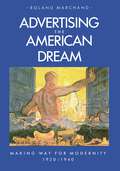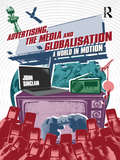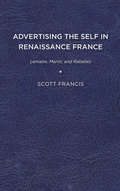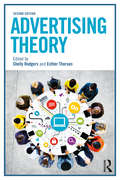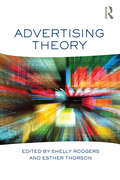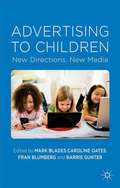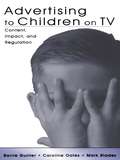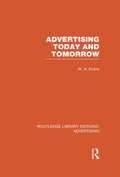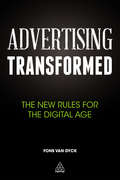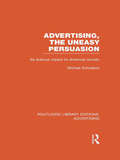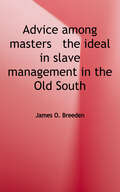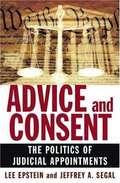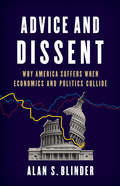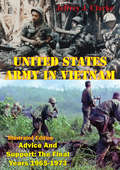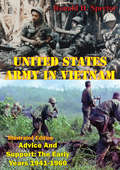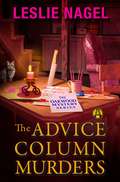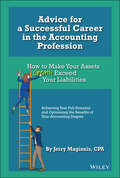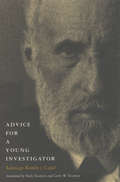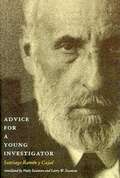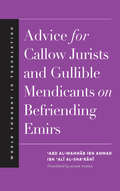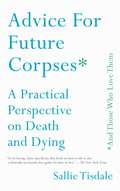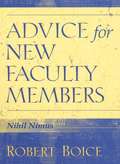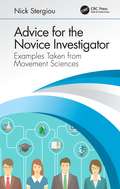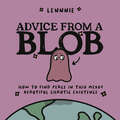- Table View
- List View
Advertising the American Dream: Making Way for Modernity, 1920-1940
by Roland MarchandIt has become impossible to imagine our culture without advertising. But how and why did advertising become a determiner of our self-image? Advertising the American Dream looks carefully at the two decades when advertising discovered striking new ways to play on our anxieties and to promise solace for the masses.As American society became more urban, more complex, and more dominated by massive bureaucracies, the old American Dream seemed threatened. Advertisers may only have dimly perceived the profound transformations America was experiencing. However, the advertising they created is a wonderfully graphic record of the underlying assumptions and changing values in American culture. With extensive reference to the popular media—radio broadcasts, confession magazines, and tabloid newspapers—Professor Marchand describes how advertisers manipulated modern art and photography to promote an enduring "consumption ethic."
Advertising, the Media and Globalisation: A World in Motion
by John SinclairThis book offers a critical, empirically-grounded and contemporary account of how advertisers and agencies are dealing with a volatile mediascape throughout the world, taking a region-by-region approach. It provides a clear, systematic, and synoptic analysis of the dynamic relationship between media, advertisers, and agencies in the age of globalization, and in an era of transition from ‘mass’ to ‘social’ media. Advertising attracts much public criticism for the commercialization of culture and its apparent impact on social and personal life. This book outlines and assesses the issues involved, with regard to how they are manifested in different national, regional and global contexts. Topics covered include: advertising as an object of study global trends in the advertising industry advertising and the media in motion current issues in advertising, media and society advertising, globalization and world regions. While maintaining a contemporary focus, the book explains developments over recent decades as background to the globalisation of what it calls the manufacturing-marketing-media complex.
Advertising the Self in Renaissance France: Lemaire, Marot, and Rabelais (Early Modern Exchange)
by Scott FrancisAdvertising the Self in Renaissance France explores how authors and readers are represented in printed editions of three major literary figures: Jean Lemaire de Belges, Clément Marot, and François Rabelais. Print culture is marked by an anxiety of reception that became much more pronounced with increasingly anonymous and unpredictable readerships in the sixteenth century. To allay this anxiety, authors, as well as editors and printers, turned to self-fashioning in order to sell not only their books but also particular ways of reading. They advertised correct modes of reading as transformative experiences offered by selfless authors that would help the actual reader attain the image of the ideal reader held up by the text and paratext. Thus, authorial personae were constructed around the self-fashioning offered to readers, creating an interdependent relationship that anticipated modern advertising.Distributed for the University of Delaware Press
Advertising Theory (Routledge Communication Series)
by Shelly Rodgers Esther ThorsonAdvertising Theory provides detailed and current explorations of key theories in the advertising discipline. The volume gives a working knowledge of the primary theoretical approaches of advertising, offering a comprehensive synthesis of the vast literature in the area. Editors Shelly Rodgers and Esther Thorson have developed this volume as a forum in which to compare, contrast, and evaluate advertising theories in a comprehensive and structured presentation. With new chapters on forms of advertising, theories, and concepts, and an emphasis on the role of new technology, this new edition is uniquely positioned to provide detailed overviews of advertising theory. Utilizing McGuire’s persuasion matrix as the structural model for each chapter, the text offers a wider lens through which to view the phenomenon of advertising as it operates within various environments. Within each area of advertising theory—and across advertising contexts—both traditional and non-traditional approaches are addressed, including electronic word-of-mouth advertising, user-generated advertising, and social media advertising contexts. This new edition includes a balance of theory and practice that will help provide a working knowledge of the primary theoretical approaches and will help readers synthesize the vast literature on advertising with the in-depth understanding of practical case studies and examples within every chapter. It also looks at mobile advertising in a broader context beyond the classroom and explores new areas such as native advertising, political advertising, mobile advertising, and digital video gaming.
Advertising Theory: Theory And Research (Lea’s Communication Series)
by Esther Thorson Shelly RodgersAdvertising Theory provides detailed and current explorations of key theories in the advertising discipline. The volume gives a working knowledge of the primary theoretical approaches of advertising, offering a comprehensive synthesis of the vast literature in the area. Editors Shelly Rodgers and Esther Thorson have developed this volume as a forum in which to compare, contrast, and evaluate advertising theories in a comprehensive and structured presentation. Chapters provide concrete examples, case studies, and readings written by leading advertising scholars and educators. Utilizing McGuire's persuasion matrix as the structural model for each chapter, the text offers a wider lens through which to view the phenomenon of advertising as it operates within various environments. Within each area of advertising theory - and across advertising contexts - both traditional and non-traditional approaches are addressed, including electronic word-of-mouth advertising, user-generated advertising, and social media advertising contexts. As a benchmark for the current state of advertising theory, this text will facilitate a deeper understanding for advertising students, and will be required reading for advertising theory coursework.
Advertising to Children: New Directions, New Media
by Barrie Gunter Fran Blumberg Caroline Oates Mark BladesThis important source for students, researchers, advertisers and parents reviews the debates and presents new research about advertising to children. Chapters cover food and alcohol advertising, the effects of product placement and new media advertising, and the role of parents and teachers in helping children to learn more about advertising.
Advertising to Children on TV: Content, Impact, and Regulation
by Barrie Gunter Caroline Oates Mark BladesConcern is growing about the effectiveness of television advertising regulation in the light of technological developments in the media. The current rapid growth of TV platforms in terrestrial, sattelite, and cable formats will soon move into digital transmission. These all offer opportunities for greater commercialization through advertising on media that have not previously been exploited. In democratic societies, there is a tension between freedom of speech rights and the harm that might be done to children through commercial messages. This book explores all of these issues and looks to the future in considering how effective codes of practice and regulation will develop.
Advertising Today and Tomorrow: Advertising: Advertising Today And Tomorrow (Routledge Library Editions: Advertising)
by W.A. EvansAdvertising Today and Tomorrow surveys the structure and function of modern advertising (and in particular the modern advertising agency), investigates how appropriate its machinery is for modern business requirements, and suggests how, both for the good of itself and its clients, it can best equip and refine itself for the future. It is of great use to students of business, particularly of marketing, in the colleges, universities and business schools, as well as being of great help to young people seeking to make advertising their career. First published in 1974.
Advertising Transformed
by Fons Van DyckIs advertising dead or alive? Quite simply the 20th century concept of advertising is dead and it will have to reinvent itself in order to survive. This transformation is going on as we speak. Brands that invest in advertising during an economic recession prove to overcome them quicker as times of crisis are typically moments when consumers' mental pecking order is being shaken up. When brand market shares are shifting advertising can be a determining factor for the future of brands. In Advertising: dead or alive, Fons Van Dyck offers strategic answers to questions marketers and managers have about the effectiveness of advertising in the digital age. He discusses the basics of how advertising works in marketing and communications planning today. What is the core target group of advertising? Which strategy works best? Does social media mean the end of advertising? Why is the integration of marketing and communication becoming increasingly important? Are consumers better at advertising? He addresses current advertising practice. What works best: a USP (unique selling proposition) or ESP (emotional selling proposition)? Is the future of advertising global or local? Is 'green' really a sales argument, and if it is, for what type of customer? What is the power of 'retro' in advertising? He explores what academic evidence is available today that demonstrates the added value of marketing and advertising for companies and organisations, even in times of economic recession and concludes by focusing on some of the most important topics of criticism brands and advertising in particular are facing and on how brands are responding. Backed by case studies of Effie Winning brands this book gives the reader concise and accessible insights into the modern form of advertising.
Advertising, The Uneasy Persuasion: Its Dubious Impact on American Society (Routledge Library Editions: Advertising)
by Michael SchudsonWhat does advertising do? Is it the faith of a secular society? If so, why does it inspire so little devotion? Advertising, the Uneasy Persuasion is a clear-eyed account of advertising as both business and social institution. Instead of fuelling the moral indignation surrounding the industry, or feeding fantasies of powerful manipulators, Michael Schudson presents a clear assessment of advertising in its wider sociological and historical framework, persuasively concluding that advertising is not nearly as important, effective, or scientifically founded as either its advocates or its critics imagine. ‘Dispassionate, open-minded and balanced ... he conveys better than any other recent author a sense of advertising as its practitioners understand it.’ Stephen Fox, New York Times Book Review First published in 1984.
Advice Among Masters: The Ideal in Slave Management in the Old South (Contributions In Afro-american And African Studies #No. 51)
by James O. BreedenThis collection of documents on slavery is like no other: it portrays plantation slavery from the point of view of the masters. They are in this case those slaveholders who wrote on the ideal in slave manage¬ment for the southern agricultural press during the four decades pre¬ceding the Civil War. Slave management studies were a prominent and frequent feature of the South's farm journals. An extensive sampling of these studies is included here to make readily accessible an important source for the study of slavery.
Advice and Consent: The Politics of Judicial Appointments
by Lee Epstein Jeffrey A. SegalFrom Louis Brandeis to Robert Bork to Clarence Thomas, the nomination of federal judges has generated intense political conflict. With the coming retirement of one or more Supreme Court Justices--and threats to filibuster lower court judges--the selection process is likely to be, once again, the center of red-hot partisan debate. In Advice and Consent, two leading legal scholars, Lee Epstein and Jeffrey A. Segal, offer a brief, illuminating Baedeker to this highly important procedure, discussing everything from constitutional background, to crucial differences in the nomination of judges and justices, to the role of the Judiciary Committee in vetting nominees. Epstein and Segal shed light on the role played by the media, by the American Bar Association, and by special interest groups (whose efforts helped defeat Judge Bork). Though it is often assumed that political clashes over nominees are a new phenomenon, the authors argue that the appointment of justices and judges has always been a highly contentious process--one largely driven by ideological and partisan concerns. The reader discovers how presidents and the senate have tried to remake the bench, ranging from FDR's controversial "court packing" scheme to the Senate's creation in 1978 of 35 new appellate and 117 district court judgeships, allowing the Democrats to shape the judiciary for years. The authors conclude with possible "reforms," from the so-called nuclear option, whereby a majority of the Senate could vote to prohibit filibusters, to the even more dramatic suggestion that Congress eliminate a judge's life tenure either by term limits or compulsory retirement. With key appointments looming on the horizon, Advice and Consent provides everything concerned citizens need to know to understand the partisan rows that surround the judicial nominating process.
Advice and Dissent: Why America Suffers When Economics and Politics Collide
by Alan S. BlinderA bestselling economist tells us what both politicians and economists must learn to fix America's failing economic policiesAmerican economic policy ranks as something between bad and disgraceful. As leading economist Alan S. Blinder argues, a crucial cultural divide separates economic and political civilizations. Economists and politicians often talk--and act--at cross purposes: politicians typically seek economists' "advice" only to support preconceived notions, not to learn what economists actually know or believe. Politicians naturally worry about keeping constituents happy and winning elections. Some are devoted to an ideology. Economists sometimes overlook the real human costs of what may seem to be the obviously best policy--to a calculating machine. In Advice and Dissent, Blinder shows how both sides can shrink the yawning gap between good politics and good economics and encourage the hardheaded but softhearted policies our country so desperately needs.
Advice And Support: The Final Years 1965-1973 [Illustrated Edition]
by Jeffrey J. ClarkeIncludes over 75 maps, photos and plans.In Advice and Support: The Final Years the author describes the U.S. Army advisory effort to the South Vietnamese armed forces during the period when the U.S. commitment in Southeast Asia was at its peak. The account encompasses a broad spectrum of activities at several levels, from the physically demanding work of the battalion advisers on the ground to the more sophisticated undertakings of our senior military officers at the highest echelons of the American military assistance command in Saigon. Among critical subjects treated are our command relationships with the South Vietnamese army, our politico-military efforts to help reform both the South Vietnamese military and government, and our implementation of the Vietnamization policy inaugurated in 1969. The result tells us much about the U.S. Army's role as an agent of national policy in a critical but often neglected arena, and constitutes a major contribution to our understanding of not only the events that occurred in Vietnam but also the decisions and actions that produced them.
Advice And Support: The Early Years 1941-1960 [Illustrated Edition]
by Ronald H. SpectorIncludes over 75 maps, photos and plans.The present volume describes the activities of the U.S. Army in Vietnam during World War II, military advice and assistance to the French government during the immediate post-war years, and the advisory program that developed after the Geneva Agreements of 1954. Its scope ranges from high-level policy decisions to low-echelon advisory operations in the field, presented against a background of relevant military and political developments. The author enjoyed access to the official records of the period and examined personal papers, interviews, other documentary sources, and miscellaneous published materials. Useful not only as a study of military assistance but as a view of the Army as an agent of national policy, this volume is a fitting introduction to the overall study of the conflict in Vietnam.
The Advice Column Murders: The Oakwood Mystery Series (Oakwood Mystery #3)
by Leslie NagelWhat’s the couple next door really hiding? Vintage fashionista and amateur sleuth Charley Carpenter finds out in this engrossing cozy mystery from the USA Today bestselling author of The Book Club Murders. In a small town like Oakwood, Ohio, everyone knows everyone else’s business—except for Charley Carpenter’s standoffish new neighbors, who tend to keep to themselves. But behind closed doors, Paxton Sharpe’s habit of screaming bloody murder at all hours of the day keeps Charley awake all night. Coupled with the stress of the increasingly delayed expansion of her shop, Old Hat Vintage Fashions, the insomnia is driving Charley crazy. Her only distraction? The local paper’s irreverent new advice column, “Ask Jackie.” Jackie’s biting commentary usually leaves Charley and her employees rolling on the floor, but her latest column is no laughing matter. An oddly phrased query hinting at a child in peril immediately puts Charley on high alert. After arriving home to a bloodcurdling scream next door, she follows the noise into the basement and makes a grisly discovery: the body of Judith Sharpe’s adult daughter. With Detective Marcus Trenault off in Chicago, Charley decides to take matters into her own hands. Convinced that the murder is connected to the desperate plea for help in “Ask Jackie,” she embarks on a twisted investigation that has her keeping up with the Sharpes—before a killer strikes again. Leslie Nagel’s delightful Oakwood Mystery novels can be enjoyed together or separately: THE BOOK CLUB MURDERS | THE ANTIQUE HOUSE MURDERS | THE ADVICE COLUMN MURDERS
Advice for a Successful Career in the Accounting Profession: How to Make Your Assets Greatly Exceed Your Liabilities
by Jerry MaginnisPractical guidance to optimize the benefits of your accounting degree—no matter what stage of your career! Originally conceived and designed to provide helpful advice to college and university accounting majors and early-career professionals, this book evolved into a valuable resource for those groups as well as others who may be further along in their accounting careers. It contains many practical examples and real-life experiences from a long and successful career in the profession that you won't find in any accounting, auditing, or tax textbook. And it is written in a fun and engaging style with a simple goal in mind: to share lessons learned and insights that will help accountants of all ages optimize their career opportunities! Jerry Maginnis, CPA, the former Office Managing Partner for the Philadelphia office of KPMG, one of the "Big Four" Accounting Firms, currently serves as the "Accounting Executive in Residence" at Rowan University in Southern New Jersey. In this role, he has counseled and mentored dozens of students and early career professionals. The book leverages Jerry's real-world experience and his advice and counsel is delivered in a fashion that will make you feel like you are having a one on one conversation with him! Readers will also enjoy: Advice delivered concisely: each chapter is succinct and provides essential takeaways and action plans for all points in a career A guidebook that is efficiently organized into three sections—for college and university students, for early-career professionals, for accountants of all ages and experience levels—allowing the reader to focus on the sections that are most applicable to them An excellent refresher or reminder of concepts or principles that are important to even the most successful and experienced accountants Loaded with "real world" tips and techniques, Advice for a Successful Career in the Accounting Profession is an ideal resource for accountants and auditors, tax and advisory professionals, and University professors and high school instructors teaching Accounting, undeclared business majors, underrepresented populations, and students aspiring to become CPAs.
Advice for a Young Investigator
by Santiago Ramon Y CajalAn anecdotal guide for the perplexed new investigator as well as a refreshing resource for the old pro, covering everything from valuable personality traits for an investigator to social factors conducive to scientific work.Santiago Ramón y Cajal was a mythic figure in science. Hailed as the father of modern anatomy and neurobiology, he was largely responsible for the modern conception of the brain. His groundbreaking works were New Ideas on the Structure of the Nervous System and Histology of the Nervous System in Man and Vertebrates. In addition to leaving a legacy of unparalleled scientific research, Cajal sought to educate the novice scientist about how science was done and how he thought it should be done. This recently rediscovered classic, first published in 1897, is an anecdotal guide for the perplexed new investigator as well as a refreshing resource for the old pro.Cajal was a pragmatist, aware of the pitfalls of being too idealistic—and he had a sense of humor, particularly evident in his diagnoses of various stereotypes of eccentric scientists. The book covers everything from valuable personality traits for an investigator to social factors conducive to scientific work.
Advice for a Young Investigator
by Santiago Ramón y Cajal Neely Swanson Larry W. SwansonSantiago Ramón y Cajal was a mythic figure in science. Hailed as the father of modern anatomy and neurobiology, he was largely responsible for the modern conception of the brain. His groundbreaking works were New Ideas on the Structure of the Nervous System and Histology of the Nervous System in Man and Vertebrates. In addition to leaving a legacy of unparalleled scientific research, Cajal sought to educate the novice scientist about how science was done and how he thought it should be done. This recently rediscovered classic, first published in 1897, is an anecdotal guide for the perplexed new investigator as well as a refreshing resource for the old pro. Cajal was a pragmatist, aware of the pitfalls of being too idealistic -- and he had a sense of humor, particularly evident in his diagnoses of various stereotypes of eccentric scientists. The book covers everything from valuable personality traits for an investigator to social factors conducive to scientific work.
Advice for Callow Jurists and Gullible Mendicants on Befriending Emirs
by Adam Sabra Abd al-Wahhab al-SharaniThis mirror for princes sheds light on the relationship between spiritual and political authority in early modern Egypt This guide to political behavior and expediency offers advice to Sufi shaykhs, or spiritual guides, on how to interact and negotiate with powerful secular officials, judges, and treasurers, or emirs. Translated into English for the first time, it is a unique account of the relationship between spiritual and political authority in late medieval / early modern Islamic society.
Advice for Future Corpses (and Those Who Love Them): A Practical Perspective on Death and Dying
by Sallie TisdaleA straightforward, wise, and humorous narrative field guide for both the dying and those who love them by an author who brings a unique set of qualifications to this delicate subject—she's a Pushcart Prize-winning writer, a palliative care nurse with more than ten years of experience, and a lifelong Buddhist. <P><P>If you don't plan, you're only limiting your options. We do not know when we will die. We may see it coming from far away, or all at once. But I will die and you will die. You believe that, don't you? <P><P>You get ready to die the way you get ready for a trip. Start by realizing you don't know the way. Read a few travel guides. Study the language, look at maps, gather equipment. Let yourself imagine what it will be like. Pack your bags. This book is one of those travel guides—a guide to preparing for your own death and the deaths of people close to you. <P><P>The fact of death is hard to believe. Sallie Tisdale explores our fears and all the ways death and talking about death make us uncomfortable—but she also explores its intimacies and joys. <P><P>Tisdale looks at grief, what the last days and hours of life are like, and what happens to dead bodies. Advice for Future Corpses includes exercises designed to make you think differently about the inevitable. She includes practical advice, personal experience, a little Buddhist philosophy, and stories. <P>But this isn't a book of inspiration or spiritual advice—Advice for Future Corpses is about how you can get ready. Start by admitting that we are all future corpses.
Advice for New Faculty Members: Nihil Nimus
by Robert BoiceA guide to the start of a successful academic career.
Advice for the Novice Investigator: Examples Taken from Movement Sciences
by Nick StergiouThis book is intended to help young and novice scientists by providing them with advice on how to overcome adversities. This advice comes in the form of numerous examples from the author’s career but also from the careers of many other scientists. It follows the thinking process of Ramon Y Cajal and his famous book, "Advice for a Young Investigator." It covers a variety of topics and areas that are fundamental in becoming a successful scientist. It presents chapters on all essential areas of the scientific life that appeal to a wide range of audiences, from the senior undergraduate student to the university administrator to the chief scientist in the industry. Some figures in the eBook are in color. Features Contains practical advice and many hints on a variety of topics; from how to write a grant to how to effectively manage your time Displays many examples of success and failure from other scientists that can teach valuable lessons Provides many personal stories and anecdotes in a form of sincere confessions Includes PowerPoint Presentation slides for each chapter for any academicians that want to develop such a class in their institutions
Advice from a Blob: How to Find Peace in this Messy, Beautiful, Chaotic Existence
by LennnieFrom social media sensation Lennnie, a full-color, illustrated self-care book filled with all-new insights to boost our mental health—wisdom to help us combat the negativity and hate, find acceptance and peace, and embrace the miracle of ourselves and the wonder of life itself. “Hello humans, my name’s Lennnie, I’m a little Blob that was sent by the book Gods to come check on you. So, let’s get into it shall we? It really is a chaotic tornado sh*tstorm of debauchery out there . . . but I promise you’re gonna be okay. Really Truly Absolutely Positively Fine. Even if it doesn’t feel like it right now.” At a time when many of us yearn for a world filled with more kindness, compassion, and community, Lennnie—an adorable, sassy, loving animated blob—has become a social media star. A dose of Lennnie’s gentle, down-to-earth positivity gets us get through even the darkest days, because Lennnie keeps it real, avoiding empty platitudes and reminding of us of the most important thing: love. Lennnie encourages us to disregard the haters, especially those negative voices that can fill our heads, and brings joy and happiness into our daily lives.Advice from a Blob features exclusive, all-new material covering a range of issues that matter most, both to Lennnie's avid fanbase and to everyone just discovering this beautiful little Blob. Packed with 130 unique, full-color illustrations with extended captions, this charming keepsake book offers wisdom and insights on important themes central to our mental health, including grief, loneliness, thought demons, failure, coping with change, anxiety, feeling lost, and finding your people. As Lennnie reminds us, no matter where we are in life, we’ve got this. copyright Lennnie, LLC
